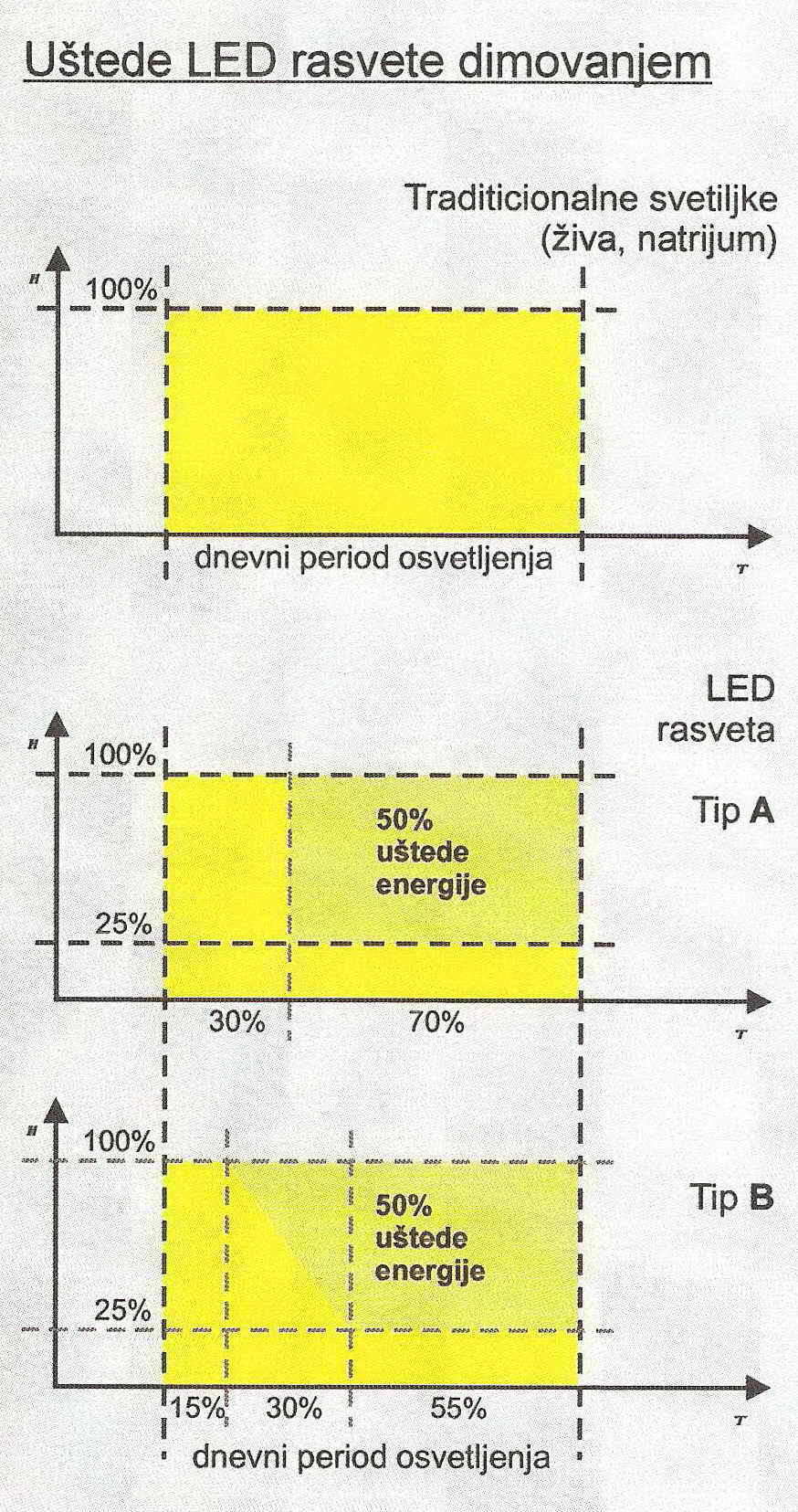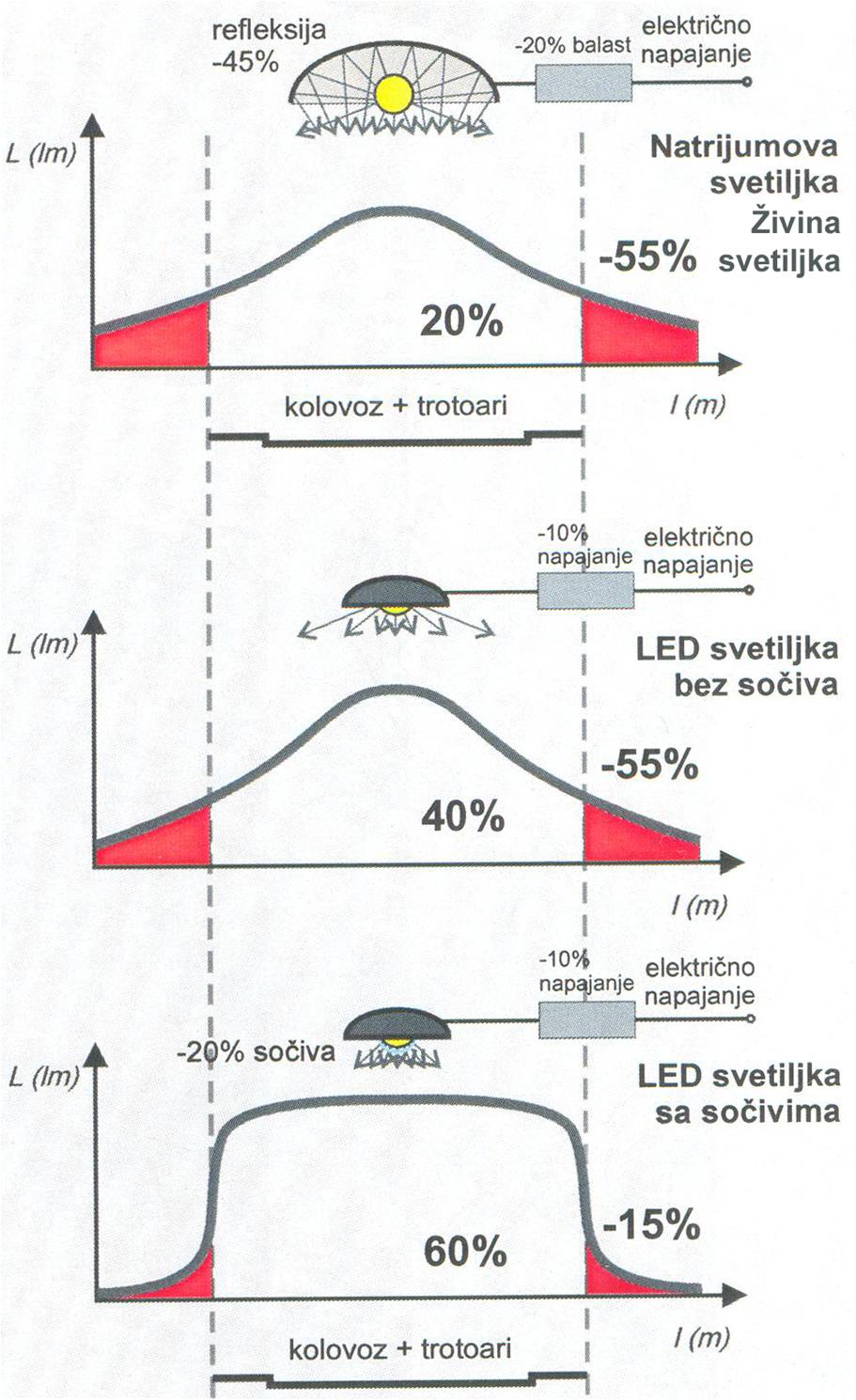INOVATIVNO KORIŠĆENјE LED DIODA U SISTEMU JAVNE RASVETE UVOĐENјEM DALjINSKOG UPRAVLjANјA
U savremenim životnim uslovima javno osvetlјenje predstavlјa bitnu infrastrukturnu komponentu, koja direktno utiče, kako na kvalitet života, tako i na izgled grada i naselјa. Ovo potvrđuju i rezultati ispitivanja javnog mnjenja u Zapadnoj Evropi. U čak 75% ispitanih gradova smatra se da je kvalitetno i dobro održavano osvetlјenje jedno od najvažnijih elemenata komunalnih sistema, i veoma je značajno za funkcionisanje celokupne infrastrukture naselјenih mesta i gradova. Danas u strukturi javnog osvetlјenja dominiraju svetilјke sa živom pod visokim pritiskom (Hg svetilјke) i svetilјke sa natrijumom pod visokim pritiskom (Na svetilјke).
U Srbiji je instalirano oko 600.000 svetilјki javne rasvete koje su u proseku snage 250W, starosti 25 godina i troše oko 430 GWh električne energije, što na godišnjem nivou čini 1,5% ukupne potrošnje električne energije u Srbiji. U strukturi postojećih svetilјki dominiraju svetilјke sa živom pod visokim pritiskom (Hg svetilјke), kao i drugi tipovi manje energetski efikasnih svetilјki, a poslednjih deset godina se intenzivnije uvodi efikasnija natrijumova sjalica visokog pritiska (Na svetilјka).
Razvoj poluprovodničke tehnologije omogućio je da se na svetskom tržištu osvetlјenja pojave svetilјke sa LED izvorima svetla (diode koje emituju svetlost), kao nova, energetski, ekonomski i ekološki superiorna tehnologija.
LED svetilјke imaju jedinstvene osobine energetske efikasnosti, upravlјanja i veka trajanja, zahvalјujući čemu imaju potencijal da, zamenom svih svetilјki u Srbiji, smanje potrošnju električne energije od približno 25 miliona eura na ispod 3 miliona eura, kao i da troškove održavanja javne rasvete, koja se procenjuje na više od 5 miliona eura, smanje bar za polovinu kroz duži radni vek novih svetilјki. Troškovi investicije bi bili toliki da bi se isplatili za manje od 4 godine, što je tri puta kraće vreme od radnog veka LED svetilјki.
Uzimajući u obzir sadašnju cenu električne energije od 0,056 €/kWh, kao i cenu LED svetilјke od oko 4 €/W, dolazi se do precizne računice da se investicija zamene natrijumovih svetilјki isplati za manje od 7,7 godina, a halogenih svetilјki za manje od 2,2 godine. U pomenutu uštedu nije uračunata i korist od umanjenja troškova održavanja zbog toga što je vreme rada LED svetilјki superiorno u odnosu na postojeće svetilјke.
Na svetilјke su znatno efikasnije od Hg svetilјki. Svetlosna efikasnost Hg svetilјki je 60 lumena (lm) po vatu (W) električne energije, a Na svetilјke 110-120 lumena po watu (lm/W). Ova svetlosna efikasnost kako Hg svetilјki tako i Na svetilјki je u tehnološkom pogledu dostigla maksimum tako da se dalјe ne može pobolјšavati.
Međutim, realna efikasnost Na i Hg svetilјki znatno je umanjena zbog problema refleksije i nemogućnosti da se celokupna emitovana svetlost usmeri na korisnu površinu. Samo oko 20% od ukupne svetlosne energije se usmerava na korisnu površinu (put, ulicu, trotoar), ostatak ide u okolni prostor kao nekorisno svetlosno zagađenje. Osim toga, iz tehnoloških razloga “dimovanje” i Na i Hg svetilјki je skoro nemoguće a i ekonomski neopravdano.
LED svetilјke imaju veću energetsku efikasnost od Na svetilјke za 65%, a od Hg svetilјke za 87%. Iz ovoga sledi da bi se prostom zamenom Na i Hg svetilјki sa LED svetilјkama postigla ušteda za navedene procente. Uz primenu programabilne regulacije intenziteta svetlosti (dimovanja) prema parametrima, da je jednu trećinu vremena intenzitet svetlosti 100%, a dve trećine vremena intenzitet svetla 25%, postiže se dodatno uvećanje efikasnosti LED svetilјke u odnosu na Na svetilјku do iznosa od 83%, odnosno 94% u odnosu na Hg svetilјku.
Na tržištu su danas komercijalno dostupni LED izvori svetla sa energetskom efikasnošću od 150 lumena (lm) po vatu (W) električne energije. Uskoro se mogu očekivati i LED izvori sa 180 lm/W.
Kao tačkasti izvori svetlosti LED svetilјke omogućavaju da se korišćenjem jednostavne optike (sočiva) skoro 60% proizvedene svetlosne energije usmeri na želјenu površinu.
U električnom pogledu LED dioda je linearni element. Ovo nam omogućava da elektronskom kontrolom, programski, regulišemo intenzitet svetla a time i potrošnju električne energije u rasponu od 0% d 100% linearno. Na ovaj način (dimovanjem) možemo postići znatne uštede (do 50%) u sistemu javnog osvetlјenja.
Radni vek LED izvora svetlosti je 50.000 radnih sati i više, što ih u poređenju sa Na izvorima (16.000 sati) i Hg izvorima (10.000 sati) čini superiornim. Zahvalјujući ovoj činjenici, LED svetlosni izvori nam i u održavanju sistema javnog osvetlјenja omogućavaju znatne uštede.
LED svetilјka primenom niza jedinstvenih tehnoloških rešenja, maksimalno iskorišćava najbolјe osobine koje LED izvori svetla nude:
- Tehničko rešenje pasivnog hlađenja koje pruža mogućnost realizacije svetilјke električne snage do 300 W, što je ekvivalent više od 30.000 lumena svetlosne energije;
- Optička kontrola svetla, koja usmeravanjem kroz specijalno projektovana sočiva, omogućava da preko 60% proizvedene svetlosne energije bude usmereno na površinu koja treba da bude osvetlјena;
- Dalјinska kontrola svetilјki, koja omogućava programsku regulaciju njenog intenziteta tokom noćnog rada;
- Vek trajanja ovih svetilјki od oko 12 godina je dvostruko duži od Na svetilјke.
Na osnovu napred izloženog može se zaklјučiti da se rekonstrukcijom postojećeg sistema osvetlјenja LED svetilјkama, dobija funkcionalno i kvalitetno osvetlјenje i postižu uštede u eksploataciji.
Rad ovakve svetilјke treba da se dalјinski podešava (dimuje) u rasponu od 0% do 100% svetlosne energije. Na ovaj način potrošnja električne energije se može dodatno smanjiti.
Primena LED rasvete
LED svetilјka je namenjena inicijalno ambijentalnom osvetlјenju ulične scene (kolovozne i trotoarske površine), urbanih raskrsnica, trgova, parkovskih površina, kao i drugih saobraćajnih objekata i površina (stanica za snabdevanje gorivom, parkig prostora). Zahvalјujući svojim funkcionalnim karakteristikama LED svetlosni izvori predstavlјaju pouzdano, trajno, energetski efikasno rešenje obezbeđujući pri tom svetlost optimalnog intenziteta i boje, prilagođenu zahtevima svake konkretne situacije.
Različitim varijantama svetlosne snage LED izvora i optike svetilјke, u kombinaciji sa visinom i međusobnim rastojanjem stubova na koje se postavlјa, moguće je odgovoriti različitim zahtevima u pogledu intenziteta i ravnomernosti osvetlјenja saobraćajne površine i njenog neposrednog okruženja. Inicijalno primenjena optika obezbeđuje uniformno osvetlјenje (iluminansu) pravougaone površine kolovoza, veću od 0,85 (minimalna/prosečna).
Posebno je značajna mogućnost dalјinskog upravlјanja radom svetilјki putem žične ili bežične serijske komunikacije. Intenzitet svetlosti se automatski (pomoću svetlosnih senzora ili na osnovu časovnika) ili posredstvom operatera može menjati u rasponu od 0 do 100%. Pri tom je potrošnja energije u potpunoj srazmeri sa intenzitetom svetlosti, što podržava razvoj i primenu inteligentnih i energetski efikasnih strategija upravlјanja osvetlјenjem.
LED rasveta ima širok spektar primene:
- Rasveta na otvorenom parking prostoru,
- osvetlјenje u pakovima i šetalištima,
- osvetlјenje biciklističhih i staza za trčanje,
- rasveta na dokovima i kejevima,
- ulična rasveta i obeležavanje većih i/ili značajnih znakova na putu,
- osvetlјenje dvorišta domova, škola, igrališta,
- rasveta farmi i fabričkih postrojenja,
- primena u vojnim bazama.
Prema raspodeli svetlosnog fluksa spadaju u direktne ili poludirekten svetilјke sa širokom distribucijom ili izuzetno širokom zavisno od potreba. Mogu dati hladnu belu, neutralnu belu i toplu belu svetlost koju u proseku daju 24-30 LED svetilјki. Po pitanju ekoloških standarda ove lampe spadaju u kategoriju „environmentally friendly“ tj. jako malo negativno utiču na sredinu u kojoj su postavlјane. Poseduju malu disipaciju, redukovana je emisija CO2 za 350 kg/god. u proseku. Pored toga ne sadrži teške metale kao i u spektru svetlosti nema ultralјubičastog zračenja, čime su daleko povolјnije po čovekovu okolinu nego li sam propisani standard.


INNOVATIVE USE OF LED DIODES IN THE PUBLIC LIGHT SYSTEM BY INTRODUCTION OF REMOTE MANAGEMENT
In modern living conditions, public lighting represents an essential infrastructure component, which directly affects both the quality of life and the appearance of the city and settlements. This is also confirmed by the results of opinion polls in Western Europe. In as many as 75% of cities surveyed, it is considered that good quality and well maintained lighting is one of the most important elements of utility systems, and it is very important for the functioning of the entire infrastructure of settlements and cities. Today in the structure of public lighting dominated by high-pressure luminaires (Hg lamps) and high-pressure sodium lamps (To luminaires).
In Serbia, about 600,000 public lighting fixtures are installed, which are on average 250W, 25 years old and spend about 430 GWh of electricity, which at the annual level makes 1,5% of total electricity consumption in Serbia. The structure of the existing lamps is dominated by high-pressure luminaires (Hg luminaires), as well as other types of less energy-efficient lamps, and in the last ten years, a more efficient high-pressure sodium sander (Na luster) is being introduced more intensively.
The development of semiconductor technology has enabled LEDs with light sources (light emitting diodes) to appear on the global lighting market, as a new, energy, economical and environmentally superior technology.
LED lamps have unique properties of energy efficiency, management and lifetime, thanks to which they have the potential, by replacing all lamps in Serbia, to reduce electricity consumption from approximately 25 million euros to under 3 million euros, as well as the costs of maintaining public lighting, which estimated at more than 5 million euros, reducing at least half for a longer life span of new lamps. The investment costs would be so much to be paid in less than 4 years, which is three times shorter than the lifetime of LED lights.
Taking into account the current electricity price of 0.056 € / kWh, as well as the price of a LED lamp of about 4 € / W, there is a precise calculation that the investment of replacement of sodium lamps is payable in less than 7.7 years, and halogen lamps for smaller from 2.2 years. In the mentioned savings, the benefit of reducing maintenance costs is also not counted because the operating time of LED lights is superior to the existing lamps.
The luminaires are significantly more efficient than Hg lamps. The luminous efficiency of the Hg luminaire is 60 lumen (lm) per watt (W) of electricity, and on the luminaires 110-120 lumens per watu (lm / W). This luminous efficiency of both Hg luminaires and Luminaires has reached the maximum in technological terms so that it can not be further improved.
However, the real efficiency of the Na and Hg luminaires is considerably diminished due to the problem of reflection and the inability to direct the entire light emitted to the useful surface. Only about 20% of the total light energy is directed to the useful surface (road, street, pavement), the rest goes to the surrounding area as a useless light pollution. In addition, for technological reasons, “smoke” and Na and Hg luminaires are almost impossible and economically unjustified.
LED lamps have a higher energy efficiency than Na lamps by 65%, and Hg lamps by 87%. From this it follows that simply replacing Na and Hg lamps with LED lamps will save for those percentages. With the application of the programmable control of the intensity of light (smoke) according to the parameters, that one third of the time is the light intensity of 100%, and two thirds of the time intensity of the light is 25%, additional efficiency of the LED lamp is achieved in relation to the lamp to the amount of 83% 94% relative to Hg lamp.
Today, LED sources of light with energy efficiency of 150 lumen (lm) per watt (W) of electricity are commercially available on the market. LED sources with 180 lm / W can soon be expected.
As point sources of light, LED lamps enable the use of simple optics (lenses) to direct almost 60% of the produced light energy to the desired surface.
In electrical terms, the LED is a linear element. This allows us to control electronic light, programmatically, the intensity of light, and thus the consumption of electricity in the range of 0% d 100% linearly. In this way (smoke) we can achieve significant savings (up to 50%) in the public lighting system.
The life span of the light source is 50,000 hours and more, which makes it superior to the sources (16,000 hours) and Hg sources (10,000 hours). Thanks to this fact, LED light sources enable us considerable savings in maintaining the public lighting system.
The LED lamp uses a series of unique technological solutions to maximize the best features that LED light sources offer:
A technical solution for passive cooling that provides the possibility of achieving an electric power lamp up to 300 W, which is equivalent to more than 30,000 lumens of light energy;
Optical light control, which by directing through specially designed lenses, allows over 60% of the produced light energy to be directed to the surface to be illuminated;
Remote control of the luminaire, which allows programmatic regulation of its intensity during night work;
The lifetime of these lamps of about 12 years is twice as long as the Na lamps.
On the basis of the exposures, it can be concluded that by reconstructing the existing lighting system with LED lights, it gets functional and high-quality lighting and achieves savings in exploitation.
The operation of this luminaire should be remotely adjusted (smoked) in the range of 0% to 100% of the light energy. In this way, electricity consumption can be further reduced.
Application of LED lighting
The LED lamp is intended for initially ambient lighting of the street scene (pavement and pavement surfaces), urban intersections, squares, park surfaces, as well as other transport facilities and surfaces (fuel stations, parking lots). Thanks to its functional characteristics, LED light sources represent a reliable, lasting, energy efficient solution ensuring the brightness of optimal intensity and color, adapted to the requirements of each specific situation.
Different variants of the light power of the LED source and the luminaire optics, combined with the height and distance between the pillars to which it is placed, is possible to respond to different requirements in terms of the intensity and uniformity of the illumination of the traffic area and its immediate environment. The initially applied optics provide a uniform illumination (illuminance) of the rectangular surface of the pavement, greater than 0.85 (minimum / average).
Particularly important is the ability to remotely control the operation of the luminaires by wire or wireless serial communication. The intensity of light is automatically (via light sensors or timer) or via an operator can be changed in the range of 0 to 100%. In doing so, energy consumption is fully proportional to the intensity of light, which supports the development and application of intelligent and energy-efficient lighting management strategies.
LED lighting has a wide range of applications:
Lighting in the open parking space,
lighting in packages and promenades,
bicycle lighting and running tracks,
lighting on docks and quays,
street lighting and marking of major and / or significant signs on the road,
lighting of the yards of homes, schools, playgrounds,
lighting of farms and factory plants,
application in military bases.
According to the distribution of light flux, they belong to direct or semi-rectangular lamps with wide distribution or extremely broad depending on needs. They can give a cool white, neutral white and warm white light, which on average give 24-30 LEDs. Regarding environmental standards, these lamps fall into the category of “environmentally friendly”, ie. they have a very negative effect on the environment in which they are placed. They have a low dissipation, the CO2 emission is reduced by 350 kg / year. on average. In addition, it does not contain heavy metals as in the light spectrum, there is no ultraviolet radiation, which is far more favorable to the human environment than the standard itself.
